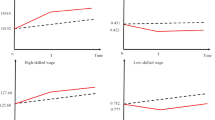Abstract
We investigate whether robots raise or lower economic well-being for generations alive during and after their development. While capital that perfectly substitutes for human labor can increase output, it can also lower labor demand and labor’s share of income. Workers who are in retirement after robots are developed benefit from high wages when young and high interest rates when old. Robots crowd out investment in capital that is complementary to workers, lowering wages for those who are working when robots are introduced. A reduction in wages will reduce saving and investment in capital that complements workers, further reducing wages for subsequent generations. On net, this shift to lower wages but higher interest rates can leave future generations worse off. Redistributing income across generations can ensure that a rise in robotic productivity benefits all generations.
Access this chapter
Tax calculation will be finalised at checkout
Purchases are for personal use only
Similar content being viewed by others
References
Acemoglu, Daron, and David Autor. 2011. “Skills, Tasks and Technologies: Implications for Employment and Earnings.” Handbook of Labor Economics 4: 1043–1171.
Arrow, K. 1962. “The Economic Implications of Learning by Doing.” The Review of Economic Studies 29 (3): 155.
Autor, David H., and David Dorn. 2013. “The Growth of Low-Skill Service Jobs and the Polarization of the US Labor Market.” The American Economic Review 103 (5): 1553–1597.
Autor, David H., Frank Levy, and Richard J. Murnane. 2003. “The Skill Content of Recent Technological Change: An Empirical Exploration.” The Quarterly Journal of Economics 118 (4): 1279–1333.
Benzell, Seth G., Laurence J. Kotlikoff, Guillermo LaGarda, and Jeffrey D. Sachs. 2015. Robots Are Us: Some Economics of Human Replacement. No. w20941. National Bureau of Economic Research.
Frey, Carl Benedikt, and Michael A. Osborne. 2013. “The Future of Employment.” Oxford Martin.
Goos, Maarten, Alan Manning, and Anna Salomons. 2010. Explaining Job Polarization in Europe: The Roles of Technology, Globalization and Institutions. No. dp1026. Centre for Economic Performance, LSE.
Katz, Lawrence F., and Robert A. Margo. 2014. “Technical Change and the Relative Demand for Skilled Labor: The United States in Historical Perspective.” In Human Capital in History: The American Record, pp. 15–57. Chicago: University of Chicago Press.
Keynes, John Maynard. 1933. “Economic Possibilities for Our Grandchildren (1930).” In Essays in Persuasion, pp. 358–373. New York: Harcourt Brace.
Long, Tony. 2017. “Jan. 25, 1921: Robots First Czech In.” WIRED [online]. Available at: http://www.wired.com/2011/01/0125robot-cometh-capek-rur-debut/.
Marx, Karl, and Ben Fowkes. 1992. “A Critique of Political Economy. Vol. 1 of Capital.”
Mishel, Lawrence, John Schmitt, and Heidi Shierholz. 2013. “Assessing the Job Polarization Explanation of Growing Wage Inequality.” Working Paper, Economic Policy Institute.
Nationalarchives.gov.uk. 2017. The National Archives Learning Curve | Power, Politics and Protest | Luddites [online]. Available at: http://www.nationalarchives.gov.uk/education/politics/g3/.
Nelson, Richard R., and Edmund S. Phelps. 1966. “Investment in Humans, Technological Diffusion, and Economic Growth.” The American Economic Review 56 (1/2): 69–75.
Olsen, Morten, and David Hemous. 2014. “The Rise of the Machines: Automation, Horizontal Innovation and Income Inequality.” In 2014 Meeting Papers, no. 162. Society for Economic Dynamics.
Rebelo, Sergio. 1991. “Long-Run Policy Analysis and Long-Run Growth.” Journal of Political Economy 99 (3): 500–521.
Romer, Paul M. 1990. “Endogenous Technological Change.” Journal of Political Economy 98 (5, Part 2): S71–S102.
Sachs, Jeffrey D., and Laurence J. Kotlikoff. 2012. Smart Machines and Long-Term Misery. No. w18629. National Bureau of Economic Research.
Schumpeter, Joseph Alois. 1939. Business Cycles, vol. 1. New York: McGraw-Hill.
Author information
Authors and Affiliations
Editor information
Editors and Affiliations
Rights and permissions
Copyright information
© 2018 The Author(s)
About this chapter
Cite this chapter
Sachs, J.D., Benzell, S.G., Lagarda, G. (2018). A One-Sector Model of Robotic Immiserization. In: Pupillo, L., Noam, E., Waverman, L. (eds) Digitized Labor. Palgrave Macmillan, Cham. https://doi.org/10.1007/978-3-319-78420-5_3
Download citation
DOI: https://doi.org/10.1007/978-3-319-78420-5_3
Published:
Publisher Name: Palgrave Macmillan, Cham
Print ISBN: 978-3-319-77046-8
Online ISBN: 978-3-319-78420-5
eBook Packages: Economics and FinanceEconomics and Finance (R0)




